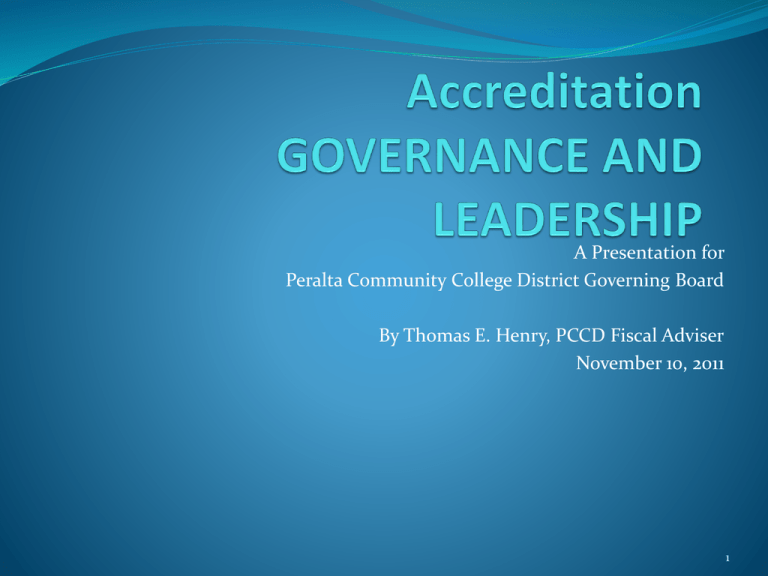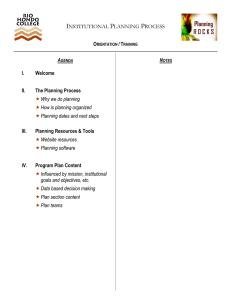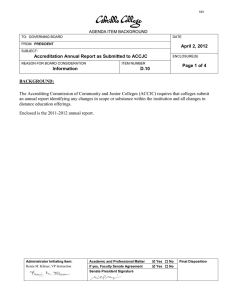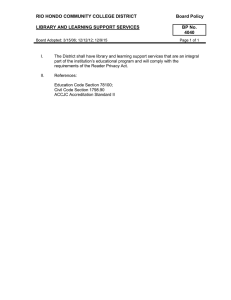10. Board Training on Accreditation 11-10-11 Tom Henry
advertisement

A Presentation for Peralta Community College District Governing Board By Thomas E. Henry, PCCD Fiscal Adviser November 10, 2011 1 Five Topics of Interest 1. Accreditation and ACCJC 2. Levels of ACCJC Sanctions 3. Five ACCJC Recommendations 4. ACCJC / PCCD Time Lines 5. Most Important Functions of Governing Board 2 Accreditation and ACCJC What is Accreditation? Accreditation is the U.S. higher education practice of reviewing and certifying the educational quality of an institution. Accreditation is a non-governmental, peer-review process in which an institution is compared against a set of standards that describe “best practices” and is expected to meet or exceed those standards. Accreditation is voluntary but is used by the U.S. Department of Education to determine eligibility for federal funds for higher education. 3 What are the purposes of accreditation? To provide quality assurance to the public so that students and others will know the institution is of sufficient quality to meet standards. To provide stimulus for continuous improvement in educational quality through periodic comprehensive evaluations, midterm reports and other interactions with the institution. 4 Accrediting Commission for Community and Junior Colleges (ACCJC) Western Association of Schools and Colleges (WASC) ACCJC accredits associate degree granting institutions in California, Hawaii, the Territories of Guam and American Samoa, the Commonwealth of the Northern Mariana Islands, the Republic of Palau, the Federated States of Micronesia, and the Republic of the Marshall Islands. ACCJC is one of three commissions under the corporate entity known as WASC. WASC is a corporate entity with three divisions. The two other accrediting commissions that are part of WASC are: The Accrediting Commission for Senior Colleges and Universities (ACSCU), and The Accrediting Commission for Schools (ACS). WASC and its three divisions are regional accreditors and accredit institutions. 5 The WASC Membership ACCJC/WASC operates in the Western Region: California, Hawaii, Republic of Palau, Guam, Saipan, Federated States of Micronesia, The Republic of the Marshall Islands, and American Samoa. ACCJC member institutions are public, private, secular, faith-based, non-profit and for-profit. 6 Who are the Commissioners? The ACCJC/WASC is composed of 19 Commissioners selected form the member institutions of the ACCJC and from the Public. 5 public 5 faculty 3 administrators 1 Hawaii CCs 1 PPEC 1 California CCs 1 ACSCU 1 ACS 1 Private Institution 7 What Are Eligibility Requirements? The Eligibility Requirements (ERs) must be met completely in order for institutions to apply for accreditation. Compliance with the criteria is expected to be continuous, and institutions that have achieved accreditation must demonstrate that they continue to meet the eligibility requirements in their self study reports and their comprehensive evaluation. There are 21 Eligibility Requirements (Accreditation Reference Handbook) ERs 17 (Financial Resources) and 18 (Financial Accountability) address financial stability. 8 What are the Standards? Standards are statements of institutional good practice that, if followed, lead to educational effectiveness and quality. They are minimum conditions that must be met to gain and retain accreditation. They are a blueprint for sound educational, administrative, financial and governance practices. 9 The Four Standards I. Institutional Mission and Effectiveness II. Student Learning Programs and Services III. Resources IV. Leadership and Governance 10 What’s New in the Standards Accreditation Standards published in 2002 (2001 for ACSCU) have new requirements that: Institutions engage in ongoing assessment of educational quality and improvement. Institutions identify and use student learning outcomes as a key indicator of their educational effectiveness in addition to other measures. Institutions provide evidence of their effectiveness. 11 What’s New in the Standards The Standards specify the role of the president/chancellor in assuring institutional quality. The Standards specify more precisely the role of the governing board and include one prohibition on governing board behavior. The Standards integrated the previous 10 standards into four, and require institutions and teams to do integrated, holistic analyses of institutional quality. Institutions demonstrate an ongoing culture and practice of assessment, including institution-wide dialogue about quality and how to improve it. 12 Accreditation Top Ten Ensure structured, sustainable participation in institutional decision-making (planning and governance). Establish periodic assessment of decision-making (planning and governance) processes; use assessment for quality improvement. Use research for decision-making (planning and governance). 13 Accreditation Top Ten Establish measurable goals in strategic planning. Use data for program review. Incorporate assessment of Student Learning Outcomes in Program Review. Integrate Program Review and budget development. 14 Accreditation Top Ten Ensure institution addresses all audit and management review findings/recommendations. Clear delineation is needed regarding faculty and staff responsibilities for accreditation (institutional governance, decision making, assessment of learning, program review, strategic planning) Set aside funds for improvement of institutional quality; consider having a percentage of the revenues dedicated to “institutional improvement.” 15 Three Levels of Sanctions Issue Warning Impose Probation Order Show Cause 16 Force of Sanctions Institutions are advised that the Commission is required by the U.S. Department of Education not to allow deficiencies to exist for more than a total of two years. Faith in Current Leadership Progressive – Sustained Improvement If concerns are not resolved within this period, the Commission will take action to terminate accreditation. 17 Five ACCJC Recommendations OPEB Obligation and Strategy Standard III.D.1., b and c, and ER #17 Resolve Audit Findings (Past and Current) Standard III. D. 2. a, c, and g and ER # 18 Fiscal Stability and Capacity – Post Retirement Benefits Standard III. D. and ER # 17 Evaluation of Board Policies and Resolution of Deficiencies Standard IV.B and ER # 3 5. Fiscal Capacity to Support Quality Student Programs and Services Standard III.D, and ER #s 5 and 17 1. 2. 3. 4. 18 Focus of ACCJC Recommendations Ongoing/Annual Board and Management Training – Roles and Functions Regular Review of the Code of Ethics – Understanding and Application Define Role of Board – Relationship to the Chancellor Review of All Policies – Clear Separation Between Policy and AR Proper Reporting Structure – Adherence to the Hierarchy of the District ACCJC – Will Determine – Institutionalized within District 19 ACCJC / PCCD Time Lines Draft ACCJC Reports to Board February, 2012 District’s and Colleges Reports due to ACCJC March 15, 2012 ACCJC Follow-Up Visit April, 2012 ACCJC Hearing June 6, 7, and 8, 2012 20 Focus of Reports Regularly Scheduled Meetings Chancellor, SMT, Steering Committee Specific District and College Recommendations Emphasis Required Evidence Based Approach Data for Decision Making Focus on Quality Instruction, Institutional Effectiveness and Educational Mission Sustainability 21 Most Important Functions of Governing Board – ER #3 Policy Adoption Role Ensure Policies Provide for the Financial Stability, Quality, and Integrity of the Institution Ensure Institution’s Mission is Being Carried Out Adheres to a Conflict of Interest Policy Creating and Nurturing an Environment Conducive to Recruiting a Competent Chancellor Employment of Competent Chancellor 22


